You found your dream home. It fits your budget. You hired a home inspector. It’s all good, right? Not necessarily. There are limits to what the inspector will check. He checks for material defects that may affect the sale or the sale price of the home. He looks at what is visible. He doesn’t go scouting around trying to uncover problems that will be significant to you after you move in.

So you inspect the house also. Doing so will likely save you a lot of frustration later on. It may also save you money. You’ll be able to negotiate with the current owners to have the repairs done or lower their selling price.
You need to know that home inside and out before signing on the dotted line. So put on work gloves and sturdy shoes or boots. Grab a flashlight and a couple tools to poke around with. No one cares as much about the condition of the home as you do.
Roof
 Roof leaks are the primary problem missed in home inspections. As a rule, home inspectors are not really going to climb up onto the roof. Some may use binoculars to see what they can see from ground level. You have to get up there to make sure it’s in good condition.
Roof leaks are the primary problem missed in home inspections. As a rule, home inspectors are not really going to climb up onto the roof. Some may use binoculars to see what they can see from ground level. You have to get up there to make sure it’s in good condition.
- Asphalt Shingles: If shingles are missing or curling or if there is too much shingle gravel in the gutters, you will have some repair or replacement work ahead of you.
- Wooden Shingles/Shakes: Look for rotting, warping, and build-up of moss and lichen.
- Tile: First, don’t walk on a tile roof. From the ladder, look for broken or cracked tiles. Tiles roofs last up to 100 years, but individual tiles can break.
- Metal Sheets: Check for corrosion, punctures, rust, and warping.
Also check the gutters, downspouts, and flashing. Find out how old a roof is. The expected life of most roofs is 20-some years.
Basement
Your nose will come in handy for this inspection. Sniff out damp or musty odors. Look for evidence of water leakage on the floor and ceiling and around the foundation. See if those exposed wooden beams are rotting. Look for cracks in the walls. Check plumbing systems in the basement for signs of leakage.
If the house has a crawl space, get in there and look for moisture, cracks in the foundation, and deteriorating exposed wood.
Attic
Again, get your nose tuned in to damp and musty odors. Look for evidence of water leakage and damage on the ceiling and walls. See if the insulation has water damage. Also, make sure that there is adequate insulation for the local climate.
Fireplace and Chimney
 The mortar should not be crumbling and loose. Look for a rain cap on the chimney. Examine the exterior of the chimney for stains due to smoke or creosote.
The mortar should not be crumbling and loose. Look for a rain cap on the chimney. Examine the exterior of the chimney for stains due to smoke or creosote.
HVAC
Check the models and capacity to ensure you have the appropriate size for the house. Also, find out how old they are. An AC unit needs to be tuned up, cleaned and checked every year. A furnace lasts 15-18 years. If you have any concerns, hire a certified professional to inspect these systems.
Plumbing
In the bathroom and kitchen, look for water stains, sagging floors, and/or mildew in plumbing areas. Turn on every faucet to assess the water pressure. Check how well sinks and tubs drain. Inspect toilets for pressure and for leaks.
On the water heater, check the model and capacity to make sure the size is sufficient for you and your family. Find out the age. A water heater lasts around 10 years. The regular plumbing inspection is generally based on these kinds of steps and it is recommended to get it once every two years.
Electrical
 The fuse box or main breaker box should be easily accessible and in good condition. Spliced wiring outside electric boxes is evidence of sloppy work. Not a good sign for the wiring that is hidden behind the walls. Electricity can be dangerous and even fatal. If you need work done or a more comprehensive inspection, you need to contact a licensed electrician.
The fuse box or main breaker box should be easily accessible and in good condition. Spliced wiring outside electric boxes is evidence of sloppy work. Not a good sign for the wiring that is hidden behind the walls. Electricity can be dangerous and even fatal. If you need work done or a more comprehensive inspection, you need to contact a licensed electrician.
Make sure the house has enough outlets. Kitchen and bathroom outlets need to be protected with ground fault circuit interrupters (GFCI).
Appliances
The home inspector will check some kitchen appliances briefly to see if they are working. Check them all yourself, so that you’re sure all are working. Find out how old the kitchen appliances and the washer and dryer are to approximate how much life they have left.
Doors and Windows
Open and close all doors and windows to see if they open easily and close soundly. Check around windows for mildew and moisture. Window fog usually indicates the seal is broken.
Ceilings, Walls, and Floors
 Examine drywall for signs of water damage and to see if it’s pulling away from the interior wall framing. Check for cracks in walls and ceilings, which could indicate structural damage to the house. Walk over all floor surfaces to notice any spongy or weak areas, which could indicate wet or dry rot.
Examine drywall for signs of water damage and to see if it’s pulling away from the interior wall framing. Check for cracks in walls and ceilings, which could indicate structural damage to the house. Walk over all floor surfaces to notice any spongy or weak areas, which could indicate wet or dry rot.
Pests
Termites: Look sawdust crumbs around windows, doors and molding. In the basement or crawl space, look for tubes about as round as a pencil that snake along joists. Break the tube. If termites scurry out or if the tube is rebuilt in a few days, call an exterminator and learn what they are checking as well.
Mice: The longer a home has been vacant, the more time mice have had a chance to settle in. Beware of homes that have been unoccupied for several months, at least. Of course, mice droppings are a dead giveaway that there are mice. In the garage, maybe not a big deal. Inside the house, look for voids in a wall or cabinet where the mice can enter.
Spiders: Spiders have their place in the food chain, and they help us spot moisture issues. When you see a bunch of spiders, you want to check for moisture problems particularly around pipes. But for all the good they do, some spiders are poisonous, and you just can’t have them around.
Any sign of pests and you’re going to have to deal with them once you move in. The fact is that most older homes have some sort of pest issue. Get an inspection and/or treatment before you finalize the deal.
Miscellaneous Interior
- Check that you have adequate ventilation in the bathroom.
- Inspect existing light fixtures and all light switches to make sure they work properly.
- Every bedroom should have a smoke detector, and every floor should have a carbon monoxide detector. Granted, these are small-ticket items, but if the current owners will make the updates, that’s less you’ll have to do amid the hustle and bustle of moving in.
Exterior

- Examine the foundation of the home. Hairline cracks in a block or poured concrete foundation are not uncommon. You need to be concerned about cracks that are horizontal and vertical or ones that you notice are getting wider. The ground around the foundation should slope away from it.
- Examine the siding of the home to ensure it’s in good repair.
- If the home has a deck or a porch, look for signs of decay or termite damage. Check the railings and steps to ensure they are secure.
- Check that the driveways and walkways are even and not cracking or crumbling.
- Take a walk around the property. Trees, shrubbery and other plants should not be overgrown and unkempt. If a sprinkler system is installed, make sure it works properly.
Garage
Look at the flooring to ensure it’s not stained or cracked. Check the siding of the garage. Open and close the garage doors to see if they work properly. As with the foundation of the house, make sure it’s in good condition and that the ground slopes away from it.
Home inspectors will not be looking for child-safety issues. If you have young children, you will want to keep their safety in mind. For example, are the cabinets easily accessible, are all the safety precautions in place if there is a swimming pool, do staircases present a danger of falling. Stair railing slats should be no farther apart than 2 3/8 inches so that a child’s head cannot get wedged in between them. Older homes can have slats with up to a six-inch gap.
Whether you live in an affordable city like Pittsburgh or an expensive place like New York City, it doesn’t matter, the fuse box or main breaker box should be easily accessible and in good condition. Spliced wiring outside electric boxes is evidence of sloppy work. Not a good sign for the wiring that is hidden behind the walls. Electricity can be dangerous and even fatal. If you need work done or a more comprehensive inspection, you need to contact a licensed electrician.
We’ve provided a home inspection checklist. Jot down your notes and date them. The log will provide you with a helpful reference point for as long as you live in your home.







![Best Crochet Hooks for Beginners and Pros [2020 Update] best crochet books](https://www.awebtoknow.com/wp-content/uploads/2018/01/best-crochet-books-100x70.jpg)